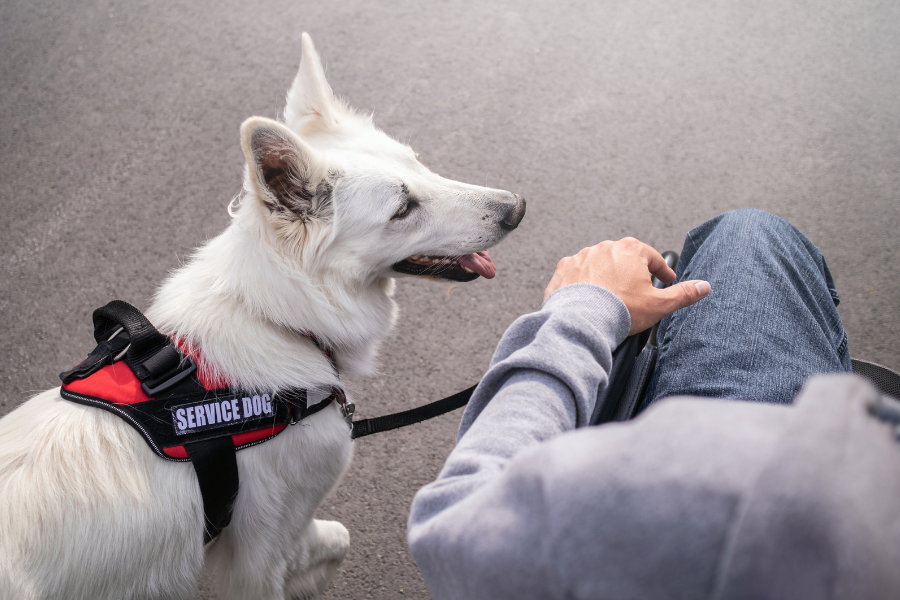
Why You Shouldn’t Pet a Service Dog: The Serious Reason Behind the Vest
- Published on:
- By: ASP Team
Service dogs are far more than friendly companions—they are expertly trained animals that perform essential tasks for individuals with disabilities.
Though it might be tempting to pet a service dog when you encounter one in public, doing so can disrupt its focus and pose serious risks to the person who depends on it for safety, stability, or independence.
In this article, we’ll explore the answer to the question “Why can’t you pet a service dog?”, what sets them apart from regular pets, and how to recognize and respect their vital role in the lives of those they assist.
Defining a Service Dog
The Americans with Disabilities Act (ADA) defines a service dog as a dog that is individually trained to perform tasks or work for the benefit of an individual with a disability.
This includes both physical disabilities, such as visual impairments or mobility challenges, and psychiatric conditions like PTSD, anxiety, or bipolar disorder. Service dogs provide essential support to their handlers, enabling greater independence and improved quality of life.
Protected by federal law, service dogs are allowed to accompany their handlers in nearly all public spaces. Their presence ensures that individuals with disabilities can navigate daily life more easily.
Learn more about psychiatric service animal laws in your state here.
Why Can't You Pet a Service Dog?
1. It Distracts Them From Their Job
A service dog is always working. Even when they seem relaxed or calm, they are trained to monitor their handler’s needs, watch for cues, and be ready to respond at a moment’s notice.
Petting the dog—even just for a second—can:
- Break its concentration
- Cause it to miss a medical alert or cue
- Increase the risk of harm to the handler
Imagine distracting a paramedic while they’re treating a patient. That’s what happens when you try to interact with a service animal on duty.
2. It Can Cause Anxiety or Confusion
Service dogs are highly trained to ignore outside distractions, including interactions with other people.
Attempting to pet or talk to a service dog can disrupt its focus, confuse its response patterns, and compromise its training. Such actions can also create stress for the handler, who may rely on the dog to manage anxiety, trauma, or other conditions.
Respecting the boundaries of a service dog is not just about the animal—it’s a way to show respect and consideration for the handler’s needs.
3. It May Put the Handler in Danger
In some cases, distraction can have serious physical consequences. For example:
- A seizure alert dog might miss the early signs of a seizure
- A mobility assistance dog might not respond to a command fast enough
- A PTSD service dog might not interrupt a dissociative episode in time
These dogs are not accessories—they are medical aids. Your interaction, however well-intentioned, could disrupt their ability to protect their person.
Get Your ESA Today
Are There Ever Times When You CAN Pet a Service Dog?
You should only pet a service dog if the handler explicitly grants permission. It’s crucial to ask first, as service dogs are usually working and must not be distracted from their duties.
A thoughtful way to ask is by saying, “Your dog is beautiful. May I pet them?” However, it’s equally important to respect the handler’s response, even if they decline. Many handlers may say no, and that is completely understandable.
In some situations, the handler might allow you to pet the dog, particularly if the dog is on a break or off-duty. Still, unless you receive clear, direct permission, always assume the dog is working and refrain from touching them. Respect for the handler and their service dog is key.
How to Recognize a Service Dog
Service dogs are often identified by:
- Vests or harnesses labeled “Service Dog” or “Do Not Pet”
- Patches with phrases like “Working Dog” or “Medical Alert”
- Specialized leashes or handles for guiding or mobility assistance
However, the ADA does not require service dogs to wear vests or carry identification. Even if a service dog isn’t visibly marked, it’s important to treat the animal with respect unless you’re certain otherwise.
For more details on ADA service dog regulations, visit our state law guide.
Can Service Dogs Be Friendly?
Absolutely! Service dogs are usually well-socialized and enjoy attention, but it’s important to remember they’re on the job and shouldn’t be distracted while working.
Even though they might seem friendly and approachable, these dogs are specially trained to stay focused so they can help their handlers effectively. Interrupting them, even with the best intentions, can make it harder for them to do their critical work.
That said, once their workday wraps up, many handlers reward their service dogs with plenty of playtime and affection to show appreciation for all their hard work.
When you see a service dog in public, just remember that their job comes first. By respecting their role, you’re helping support the safety and independence of the people who depend on them every day.
Why Can't You Pet a Service Dog - Why This Matters
People with visible and invisible disabilities rely on their service dogs every day. Whether navigating a crowded airport or managing severe anxiety in a store, a trained dog can make the difference between independence and crisis.
By respecting their role, you help:
- Maintain the dog’s training and reliability
- Protect the handler’s safety
- Normalize support for people living with disabilities
If you’d like to learn more and see if you qualify for a service dog for mental health reasons, take our assessment today.
FAQs
Can I pet a service dog if it’s not wearing a vest?
Even if a service dog isn’t wearing a vest, it’s still considered on duty unless the handler says otherwise. The ADA doesn’t require vests, so always ask the handler before approaching any dog that may be working.
What should I do if I see a service dog in public?
Give the dog space, don’t call out to it, and never try to pet or feed it. Treat the dog as you would any other medical device—by respecting its role and staying out of its way.
Why do service dogs need to stay focused all the time?
Service dogs must stay alert to subtle signals from their handler. Distractions—even brief ones—can cause them to miss a critical cue or delay their response in an emergency. Focus is essential to their job.
Conclusion
Service dogs are not just well-behaved pets—they are working medical partners trained to support people living with physical and psychiatric disabilities. While it may feel natural to reach out and say hello, and young children especially may ask “Why can’t you pet a service dog?”, it’s important to remember that doing so can interrupt the dog’s work and potentially put the handler at risk.
By keeping your distance, resisting the urge to pet, and educating others, you contribute to a more respectful and inclusive environment. Remember: if you wouldn’t touch someone’s wheelchair or oxygen tank, you shouldn’t touch their service dog.
Want to learn more about service dog training or qualifying for a psychiatric service animal?
Visit our state law guide and check out programs like iTrain Academy for a responsible and guided path to service dog preparation.

The benefits of an Emotional Support Animal certification and a Psychiatric Service Dog certification are drastically different. Fortunately for you, American Service Pets’ network of active board certified doctor or other licensed mental health providers can help you find the right path to certification. To find out whether you need an ESA or PSD letter, take our easy, three-step Pet Owner Survey!
More Great Resources





